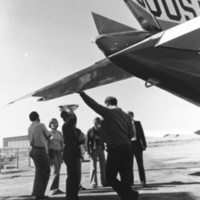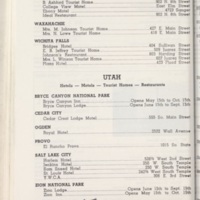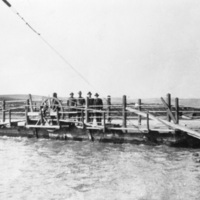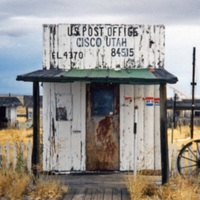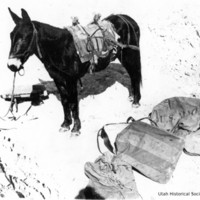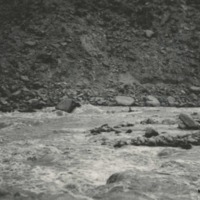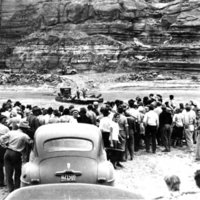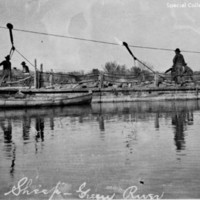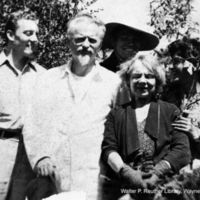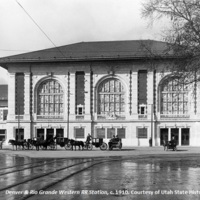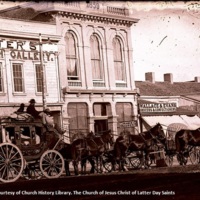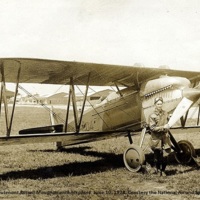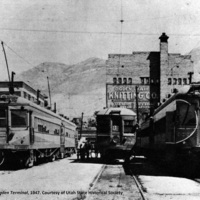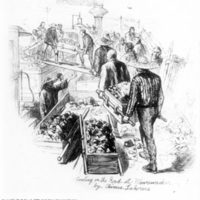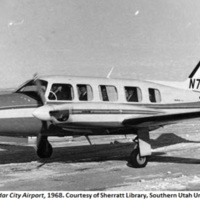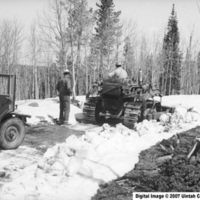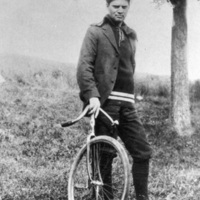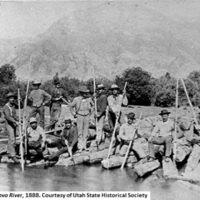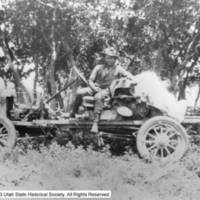Browse Items (31 total)
- Tags: Transportation
Sort by:
Flying Professors
Today, remote learning usually happens over a computer. But did you know that Utah colleges once used airplanes to bring professors directly to classrooms in rural areas? These "flying professor" programs represent just one chapter in a longer…
Utah’s Green Book
In the 1940s, new roads, affordable cars, and an interest in national parks meant that more Americans were packing up their vehicles and hitting the open road. For Black travelers driving through rural areas of Utah, the Green Book was a vital…
Ghost Towns: Dewey
There are only three roads in Utah that bridge the Colorado River, and only a handful of crossings. The ghost town of Dewey is one of those places and early settlers of the region made good use of this crossing.
Getting across the Colorado River is…
Ghost Towns: Cisco
A former railroad and ranching hub, the tiny settlement of Cisco became a ghost town after highway travel through the remote area was rerouted. But is Cisco still a ghost town today?
On the eastern edge of Grand County, a few miles south of…
The Death Hollow Trail: Delivering Mail by Mule to Boulder
Today, our mail is delivered in large trucks and often takes just a day or two to reach its final destination. But for one Utah town, mail was delivered by mule well into the twentieth century.Rain, sleet, snow, or hail, we expect mail to be…
Utah v. United States: the 1931 Riverbed Case
Water law in the West can be complicated. Find out how river runners helped the government decide who owns the riverbed of the Colorado Basin, and why that even matters to the public.
In the late 1920s, the state of Utah wanted to use the riverbeds…
Tags: County: Statewide, Date: 1920-1945, Industry, Law, Mining, Transportation, Water
Town that Drowned: Hite
Underneath Lake Powell is a drowned ghost town that was once an important mining hub and crossroads for the Colorado River community.
If you’ve ever visited the north end of Lake Powell, you may have stopped by the Hite Marina for a public restroom…
Obstacle or Opportunity? Winter Shapes Lives in Cache Valley
Winters in northern Utah’s Cache Valley are harsh. To survive and thrive, indigenous Shoshone peoples and Mormon settlers were faced with the question of “Will the challenges of winter make you or break you?”
Fur trappers who wintered in…
Division & Connection: The Green River Crossing
The Green River is a major physical divide in eastern Utah, yet it is also a lifeline for drinking water, agriculture, and recreation. Learn how the River has been a barrier and a bridge for one community along its banks.
In the arid West, water is a…
Joseph Hansen: Right-Hand Man of Leon Trotsky
The 1940 assassination in Mexico City of Russian revolutionary Leon Trotsky has an odd Utah connection in Joseph Hansen, whose journey took him from a childhood in Richfield, Utah, to the deathbed of one of the most important leaders of the 20th…
Not the End of the Line: Salt Lake's Rio Grande Train Depot
Once a major transportation hub, Salt Lake City’s Rio Grande Train Depot has served its community well over the last century. The Rio Grande Train Depot in Salt Lake City was built in 1910. Once a major hub of transportation, the building…
To Utah by Stagecoach
The stagecoach is a legendary symbol of the American West, part of a transportation network that spanned the continent. How did Utah fit into this network? Traveling to Utah was difficult – to say the least – in the mid-19th Century. Major…
Utah's Record-Making Aviator Russell Maughan
You’ve heard of record-making aviators Charles Lindberg, Amelia Earhart, and even the Wright Brothers. But who was Russell Maughan? Born and raised in Logan, Utah, Russell Maughan was a fighter pilot in World War I, and later served as a test…
Utah's Interurban Railroads
Utah’s interurban railroads were the predecessors of light rail in Utah. At the height of the railroad age, Utah was criss-crossed with rail lines. Many of these were established to haul freight, but most of them also provided passenger…
Working on the Railroad: Utah's Chinese Pioneers
Chinese immigrant laborers built the railroad from California to Utah. On May 10, 1869 the Union Pacific and Central Pacific Railroads joined at Utah’s Promontory Point, completing the first transcontinental railroad system in the United…
It's a Bird! It's a Plane!
Airplanes played a pivotal role in attracting tourism to one southern Utah town. On September 27, 1920 the first airplane cast its shadow over Cedar City, Utah. Who was flying it? And why were they flying there? In the early 1920s,…
Weathering the Road
Think about your daily travel routines. What would you do without well-maintained roads, air-conditioning, or ways to entertain the kids? Did you know that 86% of American commuters drive cars to work and spend an average 50 minutes each day on the…
William Rishel’s Bike Ride
The 100-mile summer bike ride of William Rishel and Charlie Emise across the Great Salt Lake Desert almost ended in disaster.
In 1896, to promote his growing chain of national newspapers, publisher William Randolph Hearst cooked up a wildly…
"Tieing" Utah Together
Utah’s mountain ranges were raided and its rivers put to work in order to build the national railroad system. When the transcontinental railroad came to Utah in 1868 and 1869 – and as branch lines later spread through the territory – railroad…
Tags: County: Statewide, Date: 1850-1900, Industry, Land, Transportation, Water
Adventures of an Early Hot Rodder
In the early days of motoring, traveling by automobile was all about adventure. America’s love affair with the automobile began with young men like Alva Matheson. Born in Cedar City in 1903, Alva Matheson began hankering for a car at age…

